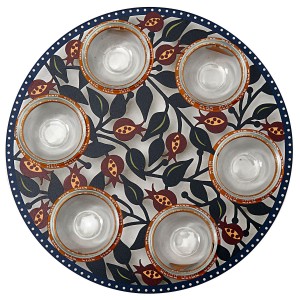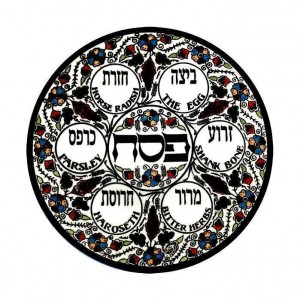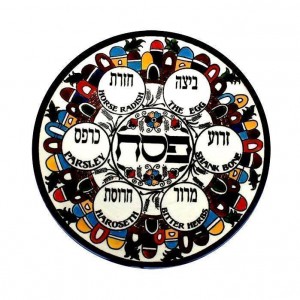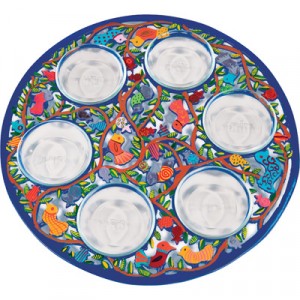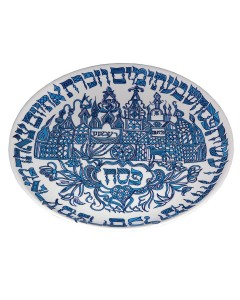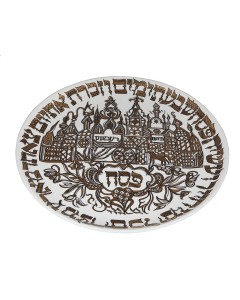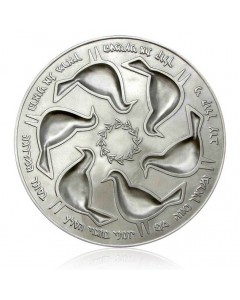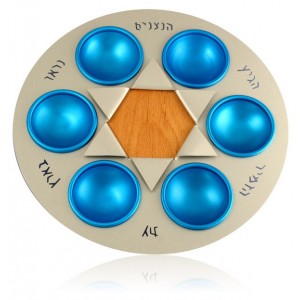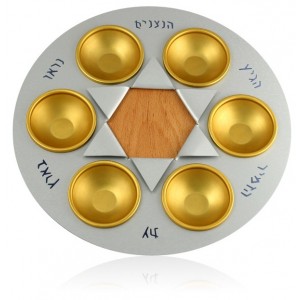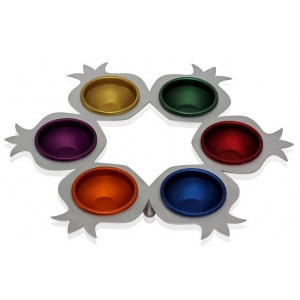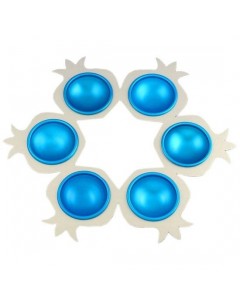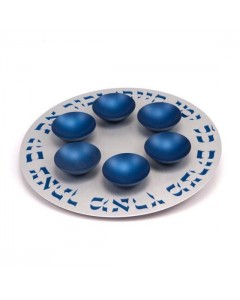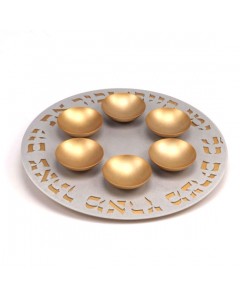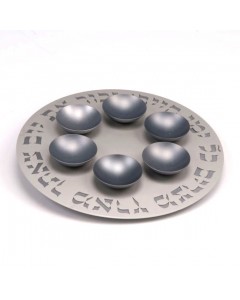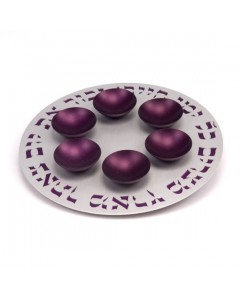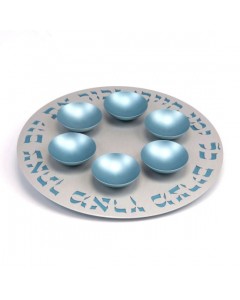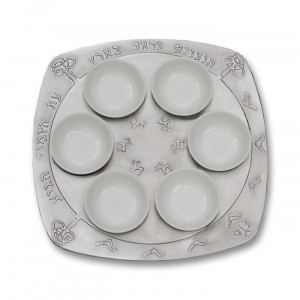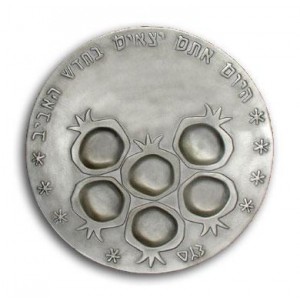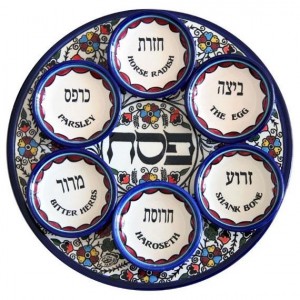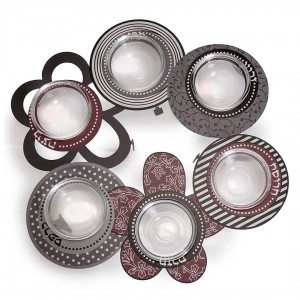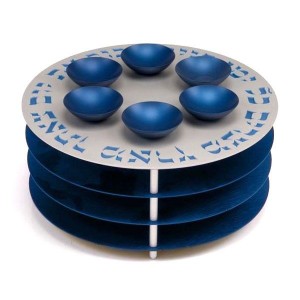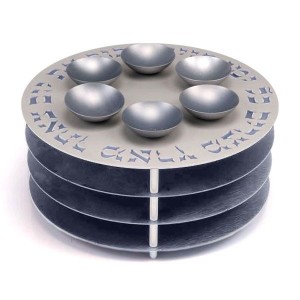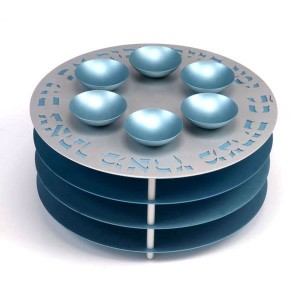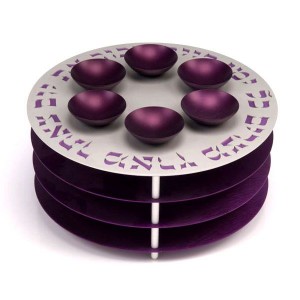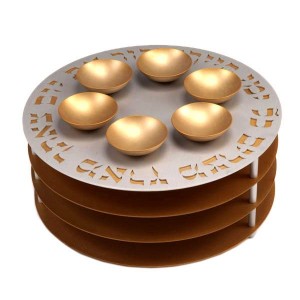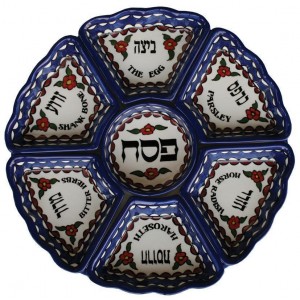The Seder plate, also known as Seder bowl or Passover Seder plate, is at the center
of every Jewish dining-room table during Passover. This is the traditional plate on which
we place six types of foods that represent concepts that relate to Pesach and the Exodus. The Charoset, a sweet mixture of fruits, wine and honey, represents the mortar that the Hebrews used to build cities in Egypt; the maror, bitter herbs, and chazeret, horseradish, symbolize the hardships that the Hebrews underwent; the karpas, any vegetable other than bitter herbs, usually potato or celery, is dipped in salt water and stands for the many tears shed by the enslaved Hebrews; the hard-boiled egg represents the korban hagigah, the festival sacrifice, that was offered in the Temple; finally the z’roa, usually a chicken wing or roasted lamb, represents the korban haPesach, the Passover sacrifice. The z’roa is only symbolic and is not eaten.
The Seder plate, in addition to playing an important religious role on Passover, plays an almost-as-important aesthetic role: being the table
centerpiece, many Jews choose to procure expensive, beautifully designed and ornate Seder plates. From aluminum Pomegranate to glass and pewter ornamented Passover Seder plate, there is a plethora of plates from which to choose.
The ceramic Seder plate has retained its popularity for many years. One of the reasons for this could be its highly diverse designs: you can find circular , square , and even pomegranate-shaped plates. Also,
one of the great things about ceramics is that in addition to coming in various materials, like silver or porcelain, they also come in many colors; the joining of white and other exuberant colors always makes for a fantastic combination. An increasingly popular trend right now is a Seder plate engraved with Hebrew quotes and images. On these you will find figures such as the twelve tribes or the twelve astrological signs, as well as six images of the six foods. Under each image is the Hebrew name and, sometimes, a short description of the image
presented.
Since there are no strict rules as to the appearance of the plate, artists have plentiful leeway when creating and designing them. Therefore, you can find creations such as Star of David Seder plates. The Star of David is often made of Sterling Silver, and between each two lines that are formed on the outside of the star are six small plates for the six foods.
Like many Judaica items, some Passover Seder plates are specially
customized for children. When there are many kids at the table, a great way to entertain them is by bunching them up and placing an additional Seder plate by their section. This plate, unlike the “adults’ ” plate, will include childish motifs such as trees and flowers, animals and more. At the center of the plate is a big “Pesach” sign in Hebrew, each letter of a different color. The kids’ Passover Seder plate, of course, is strong and doesn’t break
easily, in case the little ones decide they have had enough of the Hagaddah and that it is time to pick the plate up and play with it.
For more information on our site and its products please Contact Us.Be sure to check out our wonderful Passover learning page for more tips and ideas on what you can get your loved
one for Pesach.
Seder Plates Guide
While many Jewish holidays are traditionally observed in the synagogue, the primary observance of Passover (or “Pesach”, in Hebrew) takes place in the home with a festive meal and ritual celebration called the “Seder.” At the Seder, every participant has the chance to experience the re-telling of the story of the Exodus--the story of how G-d freed the Israelite slaves from over 400 years of servitude to the Pharaoh in Egypt. The book used to conduct the Seder is called the “Haggadah”, and it tells the Exodus story in such a way that it can be appreciated by both young and old. In fact, the telling of the story begins with a child, who asks what sounds like a simple question: Why is this night different from all other nights?
As an answer to the question, the story unfolds--with quotes from the Torah, commentary from the Talmud, songs, blessings, rituals and the Seder’s many symbols--many of which are displayed on a Seder Plate, designed especially for the occasion.
The Symbols of the Seder Plate
The Seder Plate contains at least five symbols (and often one or two more).
- The Roasted Egg (or “Beitzah”) is a symbol of fertility and springtime. Though it does not have a blessing of its own during the Seder, the festive meal traditionally begins with the eating of hard boiled eggs.
- The Charoset is a mixture that represents the mortar used by the Israelite slaves as they built Egyptian cities. Every family has its own special recipe for making Charoset, and of course, everyone’s is the best! Jews from different countries use different ingredients, but in many traditions, Charoset is made from chopped apples, nuts, spices, and wine.
- The Bitter Herb (“Maror”), usually horseradish, symbolizes the bitterness of slavery. During the Seder, the Bitter Herb is often dipped in Charoset to temper its bitterness.
- The Green Vegetable (“Karpas”), often parsley, is another symbol of Pesach as springtime holiday. During the Seder, the Karpas is dipped into Salt Water, as a symbol of the tears of the Israelite slaves. (Some Seder Plates include a place for the Salt Water and some don’t. If there is no area for it on the Seder Plate itself, Salt Water is placed separately in a bowl or bowls on the Seder Table.)
- The Shank Bone (“Zeroa”) symbolizes the Passover sacrifice of the paschal lamb back in the days when the practice of Judaism still involved animal sacrifices.
- Many Seder Plates also include a place for Lettuce (“Chazeret”) as an additional bitter herb. Some traditions include this symbol and some don’t, but those that do often cite the reason as the Biblical commandment to eat the paschal lamb sacrifice together with unleavened bread and bitter herbs (plural), Numbers 9:11.
Seder Plates
A Seder Plate is the centerpiece of any Seder Table and can be made of silver, porcelain, ceramic, or even glass. It generally has separate sections for each of the Passover symbols, with the names of the symbols painted, engraved, or etched onto the plate itself. Some people use embroidered or embellished Seder Plate covers to even further enhance the beauty of their tables. Seder Plates can be some of the most beautiful pieces of Judaica available and are often part of a family tradition that passes from parents to children to grandchildren.

